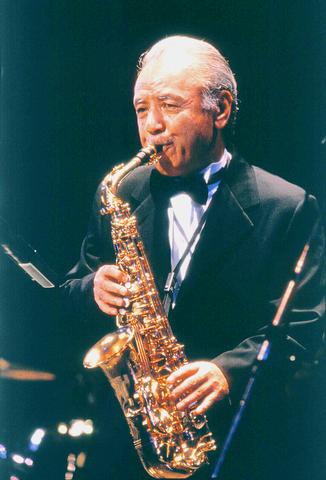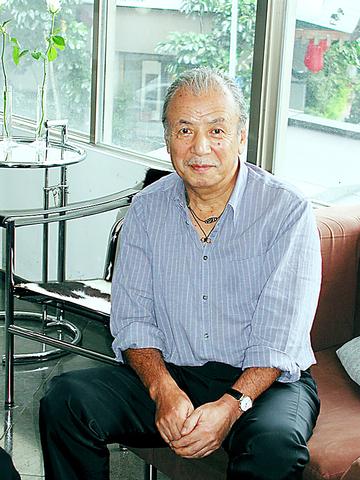By 1953 he had already made a name for himself as part of pianist Toshiko Akiyoshi's bop and jazz-orientated Cozy Quartet. When Akiyoshi moved to the US in 1956, it was the 23 year-old Watanabe who took charge of the hugely popular Tokyo-based act.

PHOTO COURTESY OF YASUHISA YONEDA
"After [Akiyoshi] left for the States, I took over for a couple of years, which was a great experience," explained Watanabe in an interview with the Taipei Times. "I was probably one of the youngest jazz musicians on the Tokyo circuit at the time, which made it even more exciting and a real challenge."

PHOTO COURTESY OF PARIS INTERNATIONAL
The sax player moved to the US himself in 1962, and spent three years studying at the Berkley College of Music in Boston. It was while studying in Boston that Watanabe first had the opportunity to work with some of the biggest names in jazz such as Gary McFarland, Chico Hamiltion and Gabor Szabo.
"The day I arrived in New York City in 1962 Toshiko Akiyoshi took me to see the Charlie Mingus Group, which she was performing with at the time," continued the sax player while lighting up a Mild Seven cigarette. "Of course, to get straight off an airplane and be surrounded by so many great names in jazz and then continue to meet so many well known musicians was quite daunting at the time."
After he returned to Japan in 1965 and formed his own band, Watanabe was soon caught up in the Bossa Nova boom that was sweeping Japan at the time. Even today many jazz fans in Japan credit him with having been a major influence and a leading figure in the Bossa Nova scene of the 1960s.
"I stated playing Samba and Bossa Nova for myself to begin with. I wasn't trying to start a fashion or anything it was purely a personal decision based on my mood at the time," he stated in between puffs. "Previous to this most of the jazz musicians in Japan simply copied a lot of straight jazz directly form records."
By the time Watanabe cut his first record in June of 1967 -- the jazz-pop influenced Nabasada and Charlie -- the young saxophonist was already considered by many as Japan's premier alto and soprano sax player.
After conquering his native Japan, Watanabe set about attempting to carve out a name for himself in the international jazz scene. His first performance in front of a truly international audience was at the Newport Jazz Festival in 1968.
"I had a real hard time. I was playing with the rhythm section for Duke Ellington's band and I kept asking them if they knew this track or that track," Watanabe recalled.
"Of course they did, but I was so nervous I didn't think about anything but performing as best I could."
The sax player continued to be a regular at jazz festivals from Monterey to Montreux throughout the 1970s and early 1980s. International chart success, however, was to elude the talented musician for almost four decades. Watanabe's one and only US chart success came in 1989, when his 1988 album, Elis spent four weeks in the number one slot of the Radio and Records Jazz Chart. The album also enjoyed seminal success in Europe.
Throughout the 1970s, Watanabe continued to team up with host of well known jazz artists including Chick Corea and the Galaxy All-Stars as well as recording a string of solo albums.
While international super-stardom proved illusive, Watanabe continued to build up a huge fan base in his native Japan. In 1972 he began hosting his own radio show. Entitled Sadao Watanabe -- My Dear Life, the jazz show became one of Japan's most successful radio programs of all time and ran for a total of 19 years.
In the 1980s, Watanabe spent less time touring and instead settled down to begin what would be a decade of industrious recording. Spending a behemoth number of hours in smoky recording studios in Japan and the US, Watanabe chalked up a total of 17 albums between 1980 and 1989.
Signed to the prestigious jazz label, Verve, in 1997, Watanabe traveled to Europe the same year, where he kicked off his first European tour since the mid-80s with a sell-out performance at the celebrated Montreux Jazz Festival.
Although much of Watanabe's early material was heavily influenced by jazz-great Charlie Parker, the talented sax player has taken his music along some singular and interesting routes in recent years. Never one to shy away from diversity, Watanabe has blended straight jazz with bebop, Latin and even African rhythms in order to create some truly unique sounds.
"I chose to incorporate African and Brazilian music into my jazz because I like them. There was no deep underlying reasoning behind it. And I certainly wasn't aiming to revolutionize jazz music," Watanabe said.
In order to keep local audiences on their toes this weekend, the Japanese jazz aficionado has opted to perform a mixed bag of material ranging from straight-edge jazz dating back to the 1960s to some of his contemporary world-music influenced style jazz.

Most heroes are remembered for the battles they fought. Taiwan’s Black Bat Squadron is remembered for flying into Chinese airspace 838 times between 1953 and 1967, and for the 148 men whose sacrifice bought the intelligence that kept Taiwan secure. Two-thirds of the squadron died carrying out missions most people wouldn’t learn about for another 40 years. The squadron lost 15 aircraft and 148 crew members over those 14 years, making it the deadliest unit in Taiwan’s military history by casualty rate. They flew at night, often at low altitudes, straight into some of the most heavily defended airspace in Asia.

Beijing’s ironic, abusive tantrums aimed at Japan since Japanese Prime Minister Sanae Takaichi publicly stated that a Taiwan contingency would be an existential crisis for Japan, have revealed for all the world to see that the People’s Republic of China (PRC) lusts after Okinawa. We all owe Takaichi a debt of thanks for getting the PRC to make that public. The PRC and its netizens, taking their cue from the Chinese Communist Party (CCP), are presenting Okinawa by mirroring the claims about Taiwan. Official PRC propaganda organs began to wax lyrical about Okinawa’s “unsettled status” beginning last month. A Global

Taiwan’s democracy is at risk. Be very alarmed. This is not a drill. The current constitutional crisis progressed slowly, then suddenly. Political tensions, partisan hostility and emotions are all running high right when cool heads and calm negotiation are most needed. Oxford defines brinkmanship as: “The art or practice of pursuing a dangerous policy to the limits of safety before stopping, especially in politics.” It says the term comes from a quote from a 1956 Cold War interview with then-American Secretary of State John Foster Dulles, when he said: ‘The ability to get to the verge without getting into the war is

Like much in the world today, theater has experienced major disruptions over the six years since COVID-19. The pandemic, the war in Ukraine and social media have created a new normal of geopolitical and information uncertainty, and the performing arts are not immune to these effects. “Ten years ago people wanted to come to the theater to engage with important issues, but now the Internet allows them to engage with those issues powerfully and immediately,” said Faith Tan, programming director of the Esplanade in Singapore, speaking last week in Japan. “One reaction to unpredictability has been a renewed emphasis on